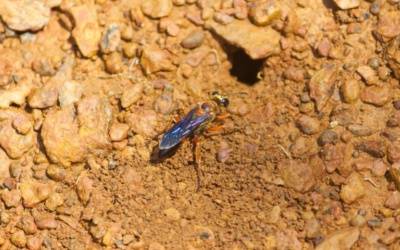Last summer, I found something new feeding at my Hydrangeas; it was a wasp, but it was orange and black and it was about three times the size of the German Wasps we typically find in our backyard.
I snapped a couple of photos and then turned to Google to figure what these new invaders were. It turns out we have a colony of Great Golden Digger Wasps nearby and they are quite fascinating.
What is a Great Golden Digger Wasp?
The Great Golden Digger Wasp is a ground dwelling insect belonging to the Sphecidae, or Thread Waisted family.
They are a large solitary wasp with primarily orange and black bodies, but they get their name from the golden hairs found on the head and thorax. They grow to about 1.5 inches, so they really stick out when buzzing around your flowers.
Are Great Golden Digger Wasps Dangerous?
As with other solitary wasp species, these wasps are not aggressive to humans. In fact, they are helping you with pest control.
The queen hunts and captures other insects like grasshoppers and crickets, paralyzes them with her sting, drags them down to her underground lair, and lays one egg horizontally on the thorax of her prey. When the egg hatches, the larva will feed off the paralyzed insect until it is mature enough to leave the nest.
Where do Great Golden Digger Wasps live?
Great Golden Digger Wasps can be found throughout the Americas and even in the Caribbean. They prefer sandier soils and can often be found in fields and prairies.
If you come across these fascinating creatures on your property, there is no need for worry. They are benign and won’t come after you like some other wasps you’ll find in your backyard.
Learn about the differences between bees and wasps, and the types of wasps that may have taken residence on your property.
And if you have issues with yellowjackets, hornets, or a wasps nest, get in touch with Croach® for professional wasp removal.




